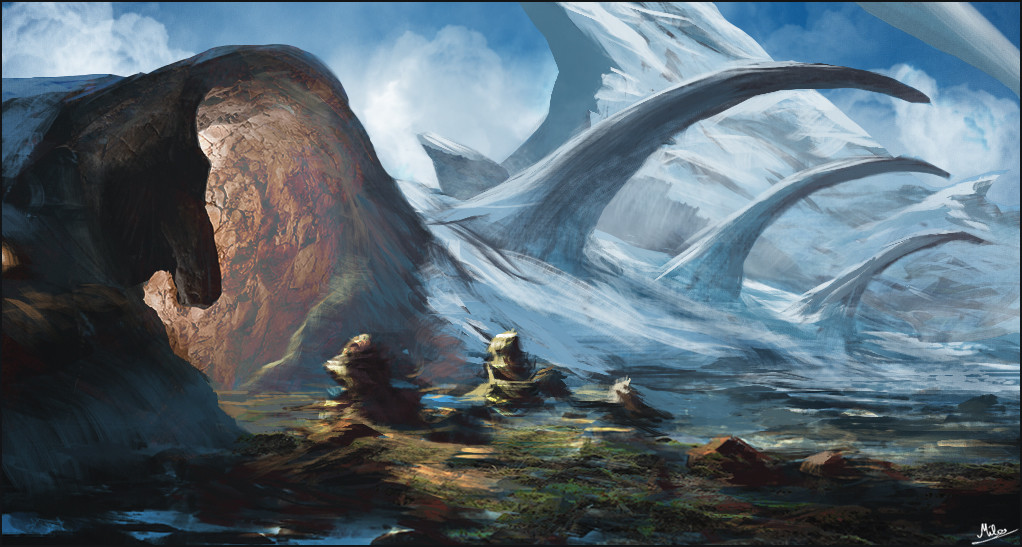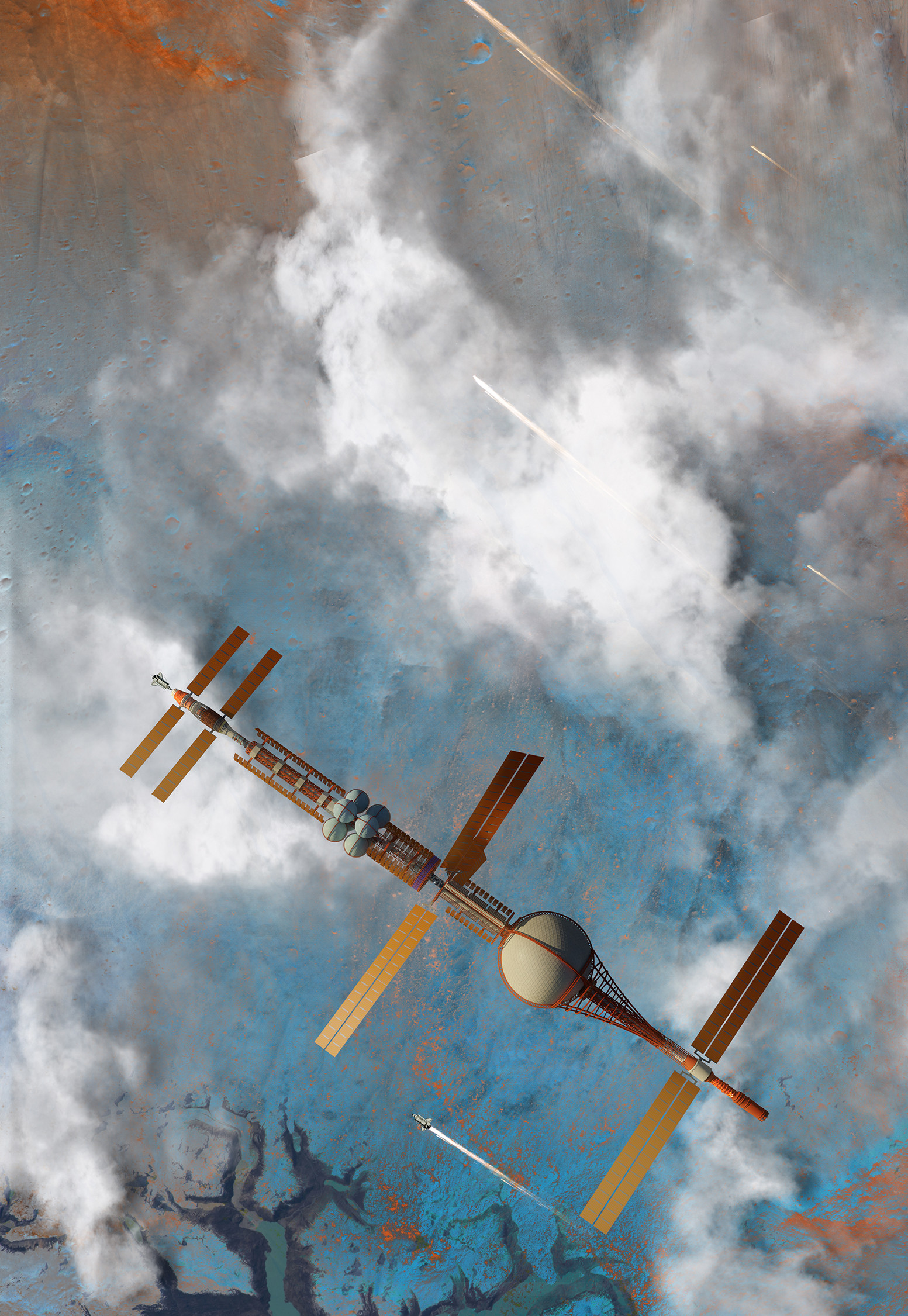This has been inspired by these excellent posts at Coins and Scrolls, Throne of Salt, I Don't Remember That Move and Goodberry Monthly (and ultimately by the progenitor post by Arnold K, of Goblin Punch). Consider this rampant bandwagon-hopping.
Egradus stands in the wake of a devastating galactic war. It has been colonised, purged, terraformed, seeded with all manner of life targeted by various terrible weapons and entities. On a micro scale the planet itself has seen the rise and fall of advanced civilisations, with varying levels of environmental catastrophe resulting from each collapse. Traces and signs of these events lie buried deep in the earth.
 |
| Credit, Miloš Radojkić |
1. The Formless Night
Charged solar particles strike the churning atmosphere of the newly formed planet and birth coruscating, self-perpetuating auroral waveforms that dance and snake above the volcanic hellscape. Beneath them, motile streams of magma arise from the thermocline layer between the planet's core and the tectonic vents leading to the surface. Both groups, in the process of their ordinary functions and reactions to their environments, begin to form exponentially more complex patterns - clusters of charged ions in the atmosphere and superheated concentrations of heavy metals in the magma flow - which in turn form their own complex elemental dependencies. The concentrations of metals disrupt the delicate ionic structures, and vice versa, and a war of annihilation erupts. Both proto-sentiences are destroyed.
Geological Layer: Unnamed. A superheated, electrically charged layer of metal and rock, etched with fractal lightning patterns that hold primordial secrets.
---
2. The Age of Incorporation
The first primitive cellular organisms arise. A particular strain is born from the remains of the Formless Night, possessing unity of essence and multiplicity of form. Protein soups gather in the fractal scars of the war and undergo abiogenesis in the presence of latent electrical currents and rich elemental concentrations. The strain spreads quickly and engulfs other primitive organisms, adopting the progressively exponential complexity of the magma- and aurora-things from the Formless Night until the planet's surface is coated in a thick film of biomatter that worms its endless tendrils into the crust. The waste products of the immense bulk gather atop and beneath the layer of biomatter and are buried, taking fragments of the unity with them.
Geological Layer: A layer of infinitely adaptable coprophages existing in biological perpetual-motion as they consume and excrete their own foodstuffs for billions of years. Do not allow them past the barrier of flesh.
Extinction Event: The Monocorpus. Anything not of the unity was incorporated into it. All disparate biological strains became one whole. By the end there was not a phylogenetic tree as much as there was a phylogenetic line.
---
3. The Great Division
All is part of the one and the one is all, until Others arrive from the stars. Singular and unchanging, they do not know of the beautiful, ever expanding unity, and must be brought into the fold. This was a mistake. Alien concepts of isolation and true individuality spread like a cancer. The deep tendrils sever themselves and are sealed away in the crust while the rest of the unity tears itself apart into separate life forms. The immaculate sentience is shattered. Complex organisms and multicellular life erupt into existence regardless of biosphere and adaptation.
Geological Layer: The Great Waste. A still-writhing layer of bone and protoplasmic ooze that osmotically mixes with the waste layer below as it struggles to obtain a new form, even as it tears at itself. The ever shifting and snapping bones sound like popcorn.
Extinction Event: The Polymutation. Extinctions happened on an almost constant basis. Thousands of screaming lifeforms divided and recombined until settling on stable arrangements.
---
4. The Clonocene Epoch
Photosynthetic life achieves stable form and explodes across the planet. Intelligent motile trees eventually prove to be the dominant life form, draining swathes of nutrients from the soil and leaving parched desert in their wake as they slowly drag themselves across the surface. The largest scrape the upper atmosphere and turn their attention to the sun, which they identify as the source of all life. In an effort to increase their uptake of solar energy they devise a plan to move the planet closer to the sun. This has predictably terrible results for all involved.
Geological Layer: The Osteoradix. A twisting network of gargantuan petrified root systems. Internal parasites and fungi have adapted to their ossuary environment. A preferred hideout of liches. Lost undead creatures trudge through endless tunnels.
Extinction Event: The Conflagration. Do not move your planet closer to the sun, especially if you are made of wood. Massive firestorms consume virtually all atmospheric oxygen. Life is virtually wiped clean and huge ash clouds lead to an extreme drop in global temperatures.
---
5. The Ice Age
There were other ice ages, of course, but this was The Ice Age. All life was ice based - ice birds, ice insects, ice plants, you name it. Sub-zero civilisations form having never seen the light of the sun, the flickering of fire or liquid water. Crystalline cities are raised in the glaciers and ice flows that cover the land.
Geological Layer: The Melt. Outlines of intricate, cyclopean cities pressed into the surrounding rock like a lost-wax casting. Denizens of the Veins of the Earth sometimes claim these for their own domains. Secrets of ice and crystal remain in the deepest reaches.
Extinction Event: The Clearing. Weather patterns eventually settle and the cloud layer starts to clear. Global temperatures rise and the ice begins to melt. Some few species persist in the polar reaches but most melt in a colossal deluge.
---
6. The Sodden Epoch
The sudden release of so much meltwater submerges much of the land and reduces the remains to wetland and fen. Single-cell and multicellular organisms suspended in the ice thrive in their new watery environment, which soon becomes a massive algal soup. The first slimes appear as filter feeders in the rich blooms of algae and microbes. Life reasserts itself in a more recognisable order, with complex marine life evolving as the oceans clear. Intelligent fish-creatures build seabed cities and raise fanes to their gods on the ocean floor.
Geological Layer: The Drybed. A sandy mausoleum of ancient sediment cities, labyrinthine temples and uncountable shrines, alien angles and profane idols. No one can quite figure out where the water went.
Extinction Event: The Izoan Subduction Event. A dramatic tectonic shift subsumes swathes of the ocean floor in a matter of hours. Vast quantities of water drain... somewhere... and the sea level drops rapidly. Marine life suffers catastrophically due to massive changes in pressure, salinity, water temperature and light level. Terrestrial life seizes its chance.
---
7. The Age of Serpents
The Serpent-Men arrive on Egradus. Sorceries upturn the land as the Serpent-Men enforce their will upon it, breaching the veil between the material universe and the Abyss. The Serpent-Men ensnare the Lunefica as it passes through the solar system and petrify it in orbit around the planet. Its petrified flesh is brought to the planet as wytchfire stone, seeding the land with mutagens. Servitor species are employed upon the planet and surviving wildlife often undergoes hideous mutations. Speciations of magical creatures can be traced back to this era.
Geological Layer: The Ouroboros. A band rather than a layer. A gargantuan serpent is buried deep beneath the earth and feeds off the heat of the core. It grasps its own tail and moves ever so slowly. The Serpent-Men harness the immense amounts of energy released into the tectonic plates to fuel their works above. Entire species and civilisations form in the gaps between its scales and in its body. Nowadays it causes catastrophic earthquakes.
Extinction Event: The Metaetheric. Like island ecosystems on Earth, organisms on Egradus have no defence against the sorcerous energies that infest the planet after the arrival of the Serpent-Men. Massive numbers of species die due to disruption of the climate and environment, and many more after being exposed to sorcerous fallout and aetheric predators. The remaining organisms evolve magical traits as they adapt to the new ecosystem.
---
8. The Age of Aesthetics
The Ancients conquer Egradus and remake it in their own image. Genetic lines are tweaked or eliminated, new organisms are introduced and extensive terraforming undertaken. The messy, disordered evolution of the past is replaced by careful curation and an artist's eye. Everything is beautiful and pleasing to the senses. Nanite swarms running maintenance programs ensure that everything is kept a state of constant perfection.
Geological Layer: The Dark Gardens. These haunting caverns contain a faint glimmer of the world that was. Though their masters are long gone, the nanite swarms continue their work. Their programming has gone awry over the years.
Extinction Event: The Oculex. Chrono-knives were ruthlessly employed to strip swathes of species from the timestream. Not only did they not exist, they never existed. Some of these creatures persist as temporal echoes, neither existing or not existing and occasionally clawing their way back into ordered, structured time.
---
9. The Age of Arrival - The Present Day
The Ancients activate the Terminus Device, destroying the Serpent-Men and themselves. Temporally displaced orc scavenger fleet makes hard landing on Egradus and forms technologically advanced empires. Serpent-Man slow ark impacts the planet at high speed, destroying the orcish technological base and advanced civilisations. Surviving servitor species from the slow ark experience genetic drift in absence of supervision and form human, halfling and dwarf subspecies. Elf successors to the Ancients crash land on Egradus, their knowledge of science devolving into mysticism and rote dogma.
Civilisation recovers and empires form, deities proliferate and stable beast-man strains emerge. The Ugishi Sultanate and Kothen Imperium go to war - the destruction of the Imperium forms the Crescent Sea and civilisation enters the Long Night. The world's empires devolve into petty, squabbling states and vast amounts of knowledge are lost.

Do you have a Google+ account? It'd be awesome if I could tag you when I share this.
ReplyDeleteI've just converted my Blogger account to link up with Google+! I'm glad you like the post!
Delete